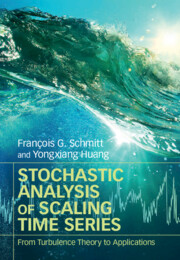Book contents
- Frontmatter
- Contents
- List of figures
- Preface
- 1 Introduction: a multiscale and turbulent-like world
- 2 Homogeneous turbulence and intermittency
- 3 Scaling and intermittent stochastic processes
- 4 New methodologies to deal with nonlinear and scaling time series
- 5 Applications: case studies in turbulence
- 6 Applications: case studies in ocean and atmospheric sciences
- References
- Index
5 - Applications: case studies in turbulence
Published online by Cambridge University Press: 05 December 2015
- Frontmatter
- Contents
- List of figures
- Preface
- 1 Introduction: a multiscale and turbulent-like world
- 2 Homogeneous turbulence and intermittency
- 3 Scaling and intermittent stochastic processes
- 4 New methodologies to deal with nonlinear and scaling time series
- 5 Applications: case studies in turbulence
- 6 Applications: case studies in ocean and atmospheric sciences
- References
- Index
Summary
In this chapter, the previous chapter's methods will be applied to several data sets obtained from the field of turbulence. The experimental velocity data was obtained from a wind tunnel experiment at the Johns Hopkins University, Baltimore, Maryland, USA. It includes also Lagrangian data obtained from a high-resolution direct numerical simulation (DNS), temperature field obtained from the Rayleigh-Bénard convection systems, and a vorticity field from a very high-resolution DNS.
Homogeneous turbulence
The experimental velocity data obtained from a wind tunnel experiment was performed by Prof. Meneveau's group with an active grid technique to achieve a high Reynolds number. The measurement locations were x/M = 20, x/M = 30, x/M = 40, and x/M = 48, where M was the mesh size and x was the downstream location. An X-type hotwire was used to measure the velocity, each time for a duration of 30 seconds (there were 30 realizations of time series measurements), with a sampling frequency of 40 kHz. In this book, we shall only consider the data obtained at the location x/M = 20. We recall here the main parameters of this data set. The Taylor's microscale based Reynolds number is Reλ ≃ 720, the mean velocity is 12.0 ms−1, and the turbulent intensity is about 15.4%. We perform the analysis of this database in the temporal domain with the implicit use of the Taylor's frozen hypothesis to convert the temporal data to the spatial one.More detail of this database can be found in Kang et al. (2003).
Fourier power spectrum and second-order structure function
Figure 5.1 shows the experimental Fourier power spectrum E(f) for both the longitudinal (solid line) and transverse (dashed line) velocity components. The Fourier power spectrum E(f) is estimated with a realization of 215 = 32768 data points each without overlap. Power-law behavior is visible for both curves on nearly two decades of frequency range 10 < f < 1000 Hz with the scaling exponents β = 1.63 ± 0.01 for the longitudinal velocity, and β = 1.61 ± 0.01 for the transverse velocity. Note that these two values are slightly smaller than the Kolmogorov value of 5/3, which could be considered as a finite Reynolds number effect. Power-law behavior is thus expected for at least the second-order structure functions on the time scales 0.001 < τ < 0.1 second; see the mathematical relation in Equation (4.5). A measurement noise is visible for the longitudinal velocity around fN ≃ 20,000Hz.
- Type
- Chapter
- Information
- Stochastic Analysis of Scaling Time SeriesFrom Turbulence Theory to Applications, pp. 101 - 161Publisher: Cambridge University PressPrint publication year: 2016



